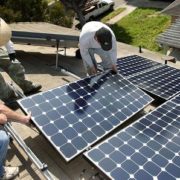A new mandate set by California regulators requires almost all newly built single-family homes to have solar panels, further establishing the Golden State as the nation’s leader in environmental regulatory efforts.
The California Energy Commission on Wednesday, May 9, unanimously voted 5-0 to approve the new measure which is slated to take effect in less than two years, starting January 1, 2020.
While a number of cities around the U.S. have residential solar panel requirements, California is the first state to have the implementation.
The requirements also apply to multifamily units that are three stories or less. Homes that are too shady will be exempted from the requirements.
They also for the first time establish requirements for newly constructed healthcare facilities. Ventilation measures to improve indoor air quality are also part of the new standards.
“Under these new standards, buildings will perform better than ever, at the same time they contribute to a reliable grid,” said Commissioner Andrew McAllister, who leads energy efficiency efforts by the Energy Commission.
A big concern coming out of the new requirement is how much the new solar installation costs would affect home buying. This, when many families in the state struggle to afford a mortgage.
The commission maintains that the requirements are meant to save consumers money in the long run through reduced utility bills, despite initial added costs.
“The buildings that Californians buy and live in will operate very efficiently while generating their own clean energy. They will cost less to operate, have healthy indoor air and provide a platform for ‘smart’ technologies that will propel the state even further down the road to a low emissions future,” said McAllister.
While the new requirements will most likely add an average of $9,500 to the construction cost of the new homes, the commission said they will offset the cost by allowing consumers to save roughly $19,000 over a 30-year mortgage.
Admitting that the new standards will add roughly $40 to average monthly payments for residential homeowners based on a 30-year mortgage, the commission said that they will also ultimately save consumers about $80 on monthly heating, cooling, and lighting bills.
Under the new standards, the commission said, “nonresidential buildings will use about 30 percent less energy due mainly to lighting upgrades.”
Solar panels have already been seeing popularity in the Golden State with California being a clear leader in installed solar capacity in the U.S. at the end of 2017. The New York Times reported that nearly 16 percent of the state’s electricity is solar powered, with the industry employing over 86,000 workers.
In regards to home construction, California adds about 80,000 new homes annually, with about 15,000 built with solar installations. SunPower Corp. — which manufacture its products mainly in the Philippines and Mexico — anticipates the new requirement to increase residential solar demand in the state by about 50 percent, reported Bloomberg.
Following Wednesday’s approval, the new regulation will now go forward for approval by the California Building Standards Commission which is expected to finalize it in October or November.
In other related environmental news, the California Environmental Protection Agency also released a new report on the same day about climate change in the state. Its consequences included the retreat of glaciers, tree mortality, the rise in ocean temperatures, and the shifting ranges of California plant and animal species.
It did though also say that California’s “pioneering policies designed to curb emissions of greenhouse gases (GHGs) have led to an overall decline in emissions as well as decreased emissions per capita and per dollar of its gross state product.”






